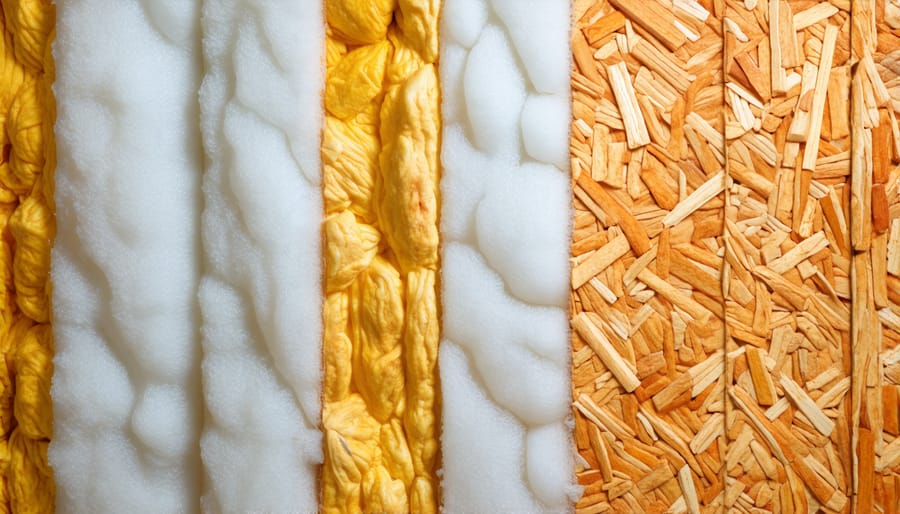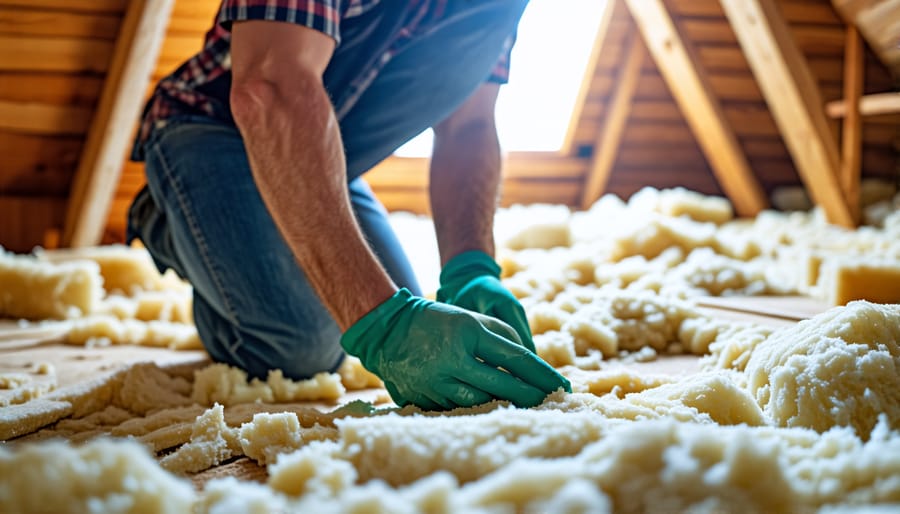Choose sustainable insulation materials that minimize environmental impact and maximize energy efficiency. Recycled denim, sheep’s wool, and cellulose are top eco-friendly options that provide excellent thermal performance while reducing your home’s carbon footprint. When selecting insulation, look for products with high R-values, which indicate superior resistance to heat flow, helping you create an energy-efficient home. Proper installation is key to maximizing the benefits of eco-friendly insulation, so follow manufacturer guidelines closely or hire a professional for optimal results. By choosing sustainable insulation, you not only contribute to a greener planet but also enjoy a more comfortable, energy-saving living space.
Understanding Eco-Friendly Insulation

Natural and Renewable Materials
When it comes to eco-friendly home insulation, natural and renewable materials are an excellent choice. Cotton, wool, hemp, and recycled materials offer sustainable options that are kind to the environment. Cotton insulation is made from post-industrial recycled cotton and treated with boric acid for fire and pest resistance. Sheep’s wool is another renewable insulation material that is naturally fire-resistant and moisture-wicking. Hemp insulation is derived from the fast-growing, carbon-sequestering hemp plant and provides excellent thermal and acoustic properties. Recycled materials like cellulose, made from recycled newspaper and treated with boric acid, and denim insulation, made from recycled jeans, are also eco-friendly options. These eco-friendly materials not only reduce waste but also create a healthier indoor environment by minimizing off-gassing and regulating moisture. When selecting natural and renewable insulation, look for products with high recycled content, low embodied energy, and minimal processing. While some of these materials may have a higher upfront cost, their durability, energy efficiency, and environmental benefits make them a worthwhile investment in the long run.
Low Embodied Energy
Embodied energy refers to the total energy consumed throughout the lifecycle of a product, from raw material extraction to manufacturing, transportation, installation, and disposal. Insulation materials with high embodied energy, such as extruded polystyrene or closed-cell spray foam, require significant energy input during production and contribute to greenhouse gas emissions.
On the other hand, insulation options with low embodied energy, like cellulose, sheep’s wool, or recycled denim, are more eco-friendly. These materials often come from renewable or recycled sources and demand less energy during manufacturing. By choosing insulation with reduced embodied energy, you can minimize the environmental impact of your home improvement project without compromising on thermal performance.
Moreover, insulation with low embodied energy often has additional green benefits. For example, cellulose is made from recycled newspaper, which diverts waste from landfills. Sheep’s wool is a natural, renewable resource that is biodegradable and can even absorb and neutralize indoor air pollutants. When selecting eco-friendly insulation, consider both the embodied energy and the broader environmental advantages of each material to make the most sustainable choice for your home.

Top Eco-Friendly Insulation Options
Sheep’s Wool
Sheep’s wool is a natural, renewable insulation material that offers excellent thermal and acoustic properties. It’s breathable, helping to regulate humidity and prevent moisture buildup, which can improve indoor air quality and reduce the risk of mold growth. Wool insulation is also naturally fire-resistant and doesn’t release harmful chemicals when exposed to heat. However, wool insulation can be more expensive than synthetic alternatives and may require professional installation for optimal performance. It’s also important to ensure the wool is treated to resist pests and mold, as untreated wool can be attractive to insects and prone to moisture-related issues. Despite these drawbacks, sheep’s wool remains a popular choice for eco-conscious homeowners seeking a sustainable, high-performing insulation solution that promotes a healthier living environment.
Cotton/Denim Batts
Cotton and denim batts are an eco-friendly insulation option made from recycled materials like old jeans and cotton scraps. These soft, fluffy batts are treated with boric acid, a natural fire retardant, making them safe and effective for home use. Cotton and denim insulation offers an R-value of around 3.5 per inch, providing good thermal resistance. It’s also breathable, helping to regulate moisture and prevent mold growth in your walls. Unlike fiberglass, cotton and denim batts are non-toxic and easy to handle without protective gear. They can be cut to size with a serrated knife and fitted snugly between wall studs or ceiling joists. As a bonus, using recycled cotton and denim helps divert textile waste from landfills, making this insulation choice a win-win for your home and the environment. Consider cotton or denim batts for a cozy, sustainable solution to your insulation needs.
Cellulose
Cellulose insulation, made from recycled paper products like newspapers and cardboard, is an eco-friendly choice for insulating your home. The paper is treated with boric acid, a natural fire retardant and insect repellent, making it safe and effective. Cellulose insulation has a high recycled content, often up to 85%, reducing waste in landfills. It’s also an excellent insulator, with an R-value of 3.5 per inch, helping to keep your home comfortable and energy-efficient. Cellulose can be blown into wall cavities, attics, and other hard-to-reach spaces, providing a seamless and comprehensive insulation solution. As a bonus, cellulose is often less expensive than other insulation materials, making it a budget-friendly option for eco-conscious homeowners. When installing cellulose insulation, it’s important to follow proper safety precautions and consult with a professional to ensure optimal performance and fire resistance.
Hemp Insulation
Hemp insulation is a sustainable choice that offers excellent thermal performance. Made from the strong fibers of hemp plants, this natural insulation material is biodegradable and recyclable. Hemp grows quickly without the need for pesticides or herbicides, making it an eco-friendly crop. When used as insulation, hemp fibers trap air pockets, providing effective thermal resistance and helping to regulate indoor temperatures. This reduces energy consumption for heating and cooling, lowering your home’s carbon footprint. Hemp insulation also offers sound-dampening properties, creating a quieter living environment. Unlike some conventional insulation materials, hemp is naturally resistant to mold, insects, and fire, ensuring a safer and healthier home. With its durability and long lifespan, hemp insulation is a wise investment for those seeking a green and efficient way to insulate their homes. Embrace the power of hemp for a cozier, more sustainable living space.
DIY Installation Tips
Preparation and Safety
Before diving into your eco-friendly insulation project, it’s crucial to take the necessary precautions to ensure a safe and successful installation. Always wear protective gear, including gloves, a dust mask, and eye protection, to avoid irritation from insulation fibers. If you’re working with fiberglass, opt for loose-fitting, long-sleeved clothing to minimize skin contact.
Proper ventilation is key, especially when handling materials like cellulose or spray foam. Open windows and use fans to maintain good air circulation. If you’re unsure about your DIY skills or encountering complex situations, don’t hesitate to consult a professional insulation contractor.
Before starting, assess your home’s insulation needs and identify any areas that require special attention, such as gaps, cracks, or electrical outlets. Seal these spots to prevent air leaks and maximize insulation efficiency.
Familiarize yourself with local building codes and regulations regarding insulation requirements. Some materials may have specific installation guidelines or require permits. Always follow the manufacturer’s instructions closely and take the time to properly prepare your work area, covering floors and furniture to catch any debris.
By prioritizing safety and thorough preparation, you’ll set yourself up for a successful and eco-friendly insulation project that will keep your home comfortable and energy-efficient for years to come.

Step-by-Step Installation
Here’s a step-by-step guide for installing eco-friendly insulation in your home:
1. Assess your insulation needs: Determine the areas in your home that require insulation, such as attics, walls, and crawl spaces. Check for any existing insulation and its condition.
2. Choose your eco-friendly insulation: Select an insulation material that aligns with your environmental values and meets your home’s requirements. Consider options like recycled denim, sheep’s wool, or cellulose.
3. Gather necessary tools and safety gear: Ensure you have the appropriate tools, such as a utility knife, measuring tape, and a staple gun. Don’t forget protective gear like gloves, goggles, and a dust mask.
4. Prepare the area: Clear the space where you’ll be installing the insulation. Seal any air leaks around windows, doors, and electrical outlets to maximize efficiency.
5. Measure and cut the insulation: Carefully measure the dimensions of the space you’re insulating. Cut the insulation material to fit snugly using a utility knife, ensuring there are no gaps.
6. Install the insulation: Follow the manufacturer’s instructions for installation. For batts or rolls, start at the top of the wall and work your way down, stapling the insulation in place. If using loose-fill insulation, rent a blower machine and fill the space evenly.
7. Seal and secure: Once the insulation is in place, seal any remaining gaps with expanding foam. Use a vapor barrier if recommended for your climate to prevent moisture issues.
8. Clean up and dispose of waste properly: Tidy up your work area and dispose of any waste according to local regulations. Many eco-friendly insulation materials can be recycled.
By following these steps and prioritizing eco-friendly materials, you can effectively insulate your home while minimizing your environmental impact. Remember to consult with a professional if you’re unsure about any aspect of the installation process.
Conclusion
Making your home more eco-friendly and energy-efficient is an important goal, and choosing the right insulation is a key part of that process. As we’ve seen, there are many sustainable insulation options available, from natural materials like sheep’s wool and cotton to recycled products like cellulose and denim. Each has its own unique benefits and considerations, so it’s important to research and compare them carefully before making a decision.
Remember, investing in high-quality, eco-friendly insulation not only helps the environment but can also lead to significant energy savings and a more comfortable home. Whether you choose to hire a professional or take on the project yourself with our DIY tips, making the switch to sustainable insulation is a smart choice for any homeowner looking to reduce their carbon footprint and create a healthier living space. By implementing sustainable home practices like eco-friendly insulation, you can feel good knowing you’re doing your part to protect the planet for future generations. So why not start exploring your options today and take the first step towards a greener, more energy-efficient home?